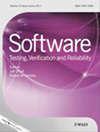How detrimental is coincidental correctness to coverage‐based fault detection and localization? An empirical study
IF 1.2
4区 计算机科学
Q3 COMPUTER SCIENCE, SOFTWARE ENGINEERING
引用次数: 5
Abstract
According to the reachability–infection–propagation (RIP) model, three conditions must be satisfied for program failure to occur: (1) the defect's location must be reached, (2) the program's state must become infected and (3) the infection must propagate to the output. Weak coincidental correctness (or weak CC) occurs when the program produces the correct output, while condition (1) is satisfied but conditions (2) and (3) are not satisfied. Strong coincidental correctness (or strong CC) occurs when the output is correct, while both conditions (1) and (2) are satisfied but not (3). The prevalence of CC was previously recognized. In addition, the potential for its negative effect on spectrum‐based fault localization (SBFL) was analytically demonstrated; however, this was not empirically validated. Using Defects4J, this paper empirically studies the impact of weak and strong CC on three well‐researched coverage‐based fault detection and localization techniques, namely, test suite reduction (TSR), test case prioritization (TCP) and SBFL. Our study, which involved 52 SBFL metrics, provides the following empirical evidence. (i) The negative impact of CC tests on TSR and TCP is very significant. In addition, cleansing the CC tests was observed to yield (a) a 100% TSR defect detection rate for all subject programs and (b) an improvement of TCP for over 92% of the subjects. (ii) The impact of CC tests on SBFL varies widely w.r.t. the metric used. The negative impact was strong for 11 metrics, mild for 37, non‐measurable for 1 and non‐existent for 3 metrics. Interestingly, the negative impact was mild for the 9 most popular and/or most effective SBFL metrics. In addition, cleansing the CC tests resulted in the deterioration of SBFL for a considerable number of subject programs. (iii) Increasing the proportion of CC tests has a limited impact on TSR, TCP and SBFL. Interestingly, for TSR and TCP and 11 SBFL metrics, small and large proportions of CC tests are strongly harmful. (iv) Lastly, weak and strong CC are equally detrimental in the context of TSR, TCP and SBFL.巧合正确性对基于覆盖率的故障检测和定位有多大危害?实证研究
根据可达性-感染-传播(RIP)模型,程序发生故障必须满足三个条件:(1)必须达到缺陷的位置,(2)程序的状态必须被感染,(3)感染必须传播到输出。当程序产生正确的输出,而满足条件(1)而不满足条件(2)和(3)时,发生弱巧合正确性(或弱CC)。当输出是正确的,同时满足条件(1)和条件(2),但不满足条件(3)时,就会出现强巧合正确性(或强CC)。CC的普遍存在是以前认识到的。此外,还分析了其对基于频谱的故障定位(SBFL)的潜在负面影响;然而,这并没有得到实证的验证。利用缺陷4j,本文实证研究了弱CC和强CC对三种基于覆盖率的故障检测和定位技术的影响,即测试套件缩减(TSR)、测试用例优先级(TCP)和SBFL。我们的研究涉及52个SBFL指标,提供了以下经验证据。(i) CC测试对TSR和TCP的负面影响非常显著。此外,清理CC测试被观察到产生(a)所有受试者程序的100% TSR缺陷检出率和(b)超过92%的受试者的TCP改进。(二)CC试验对sffl的影响因所使用的度量而有很大差异。11个指标的负面影响较强,37个指标的负面影响较轻,1个指标的负面影响不可测量,3个指标的负面影响不存在。有趣的是,对9个最流行和/或最有效的SBFL指标的负面影响是温和的。此外,清除CC测试导致相当数量的受试者项目的SBFL恶化。(三)增加CC测试的比例对TSR、TCP和sffl的影响有限。有趣的是,对于TSR、TCP和11个SBFL指标,CC测试的大小比例都是非常有害的。(iv)最后,在TSR、TCP和sffl的背景下,弱CC和强CC同样有害。
本文章由计算机程序翻译,如有差异,请以英文原文为准。
求助全文
约1分钟内获得全文
求助全文
来源期刊

Software Testing Verification & Reliability
工程技术-计算机:软件工程
CiteScore
3.70
自引率
0.00%
发文量
34
审稿时长
>12 weeks
期刊介绍:
The journal is the premier outlet for research results on the subjects of testing, verification and reliability. Readers will find useful research on issues pertaining to building better software and evaluating it.
The journal is unique in its emphasis on theoretical foundations and applications to real-world software development. The balance of theory, empirical work, and practical applications provide readers with better techniques for testing, verifying and improving the reliability of software.
The journal targets researchers, practitioners, educators and students that have a vested interest in results generated by high-quality testing, verification and reliability modeling and evaluation of software. Topics of special interest include, but are not limited to:
-New criteria for software testing and verification
-Application of existing software testing and verification techniques to new types of software, including web applications, web services, embedded software, aspect-oriented software, and software architectures
-Model based testing
-Formal verification techniques such as model-checking
-Comparison of testing and verification techniques
-Measurement of and metrics for testing, verification and reliability
-Industrial experience with cutting edge techniques
-Descriptions and evaluations of commercial and open-source software testing tools
-Reliability modeling, measurement and application
-Testing and verification of software security
-Automated test data generation
-Process issues and methods
-Non-functional testing
 求助内容:
求助内容: 应助结果提醒方式:
应助结果提醒方式:


